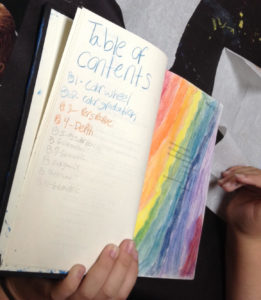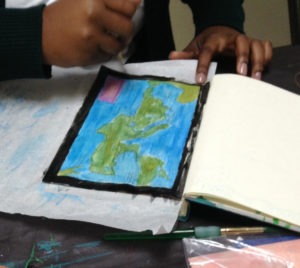I’ve always liked the idea of mixing Literacy and the Arts. After all, Art is the universal language through which to communicate.
Literacy and the English language is just a subset of communication because we are limited to 26 letters to express ourselves. In contrast, communication using Art is only limited by the possibilities of one’s imagination…
So, through our blending of Art and Literacy, we are actually equipping our students to communicate more effectively.
Why I Feel My Students Should Journal in Art
Literacy is merely one subset of communication. We are limited to 26 letters to express ourselves.
In contrast, communication using the language of Art is only limited by the possibilities of one’s imagination.
Starting Out with the Basics- Materials
I (not-so-secretly) HATE the idea of destroying texts!

Setting Up Our “Canvas”

Cover and Spine Design
Table of Contents

First Pages
The first task assignments were simple things, like
- Create a Color Wheel
- Design a Value Scale
This way, as the attacked the pages, I could get a better idea of how each child handles the artistic prompt and assess what basics they know, and where I need to fill in the gaps.
Rubrics

Class Journaling Contracts
Teacher Reflections
As the first marking period comes to a close, here are some things I observed as I assigned page tasks:
- At first, students who journal seek teacher approval, rather than enjoy the opportunity for creative expression.
- Some students sit there ‘uninspired’- usually my
- It takes a long time for a student to develop intention, rather than just place pieces on a page.
- Time management skills for Art must be taught in order for each student to reach his or her productivity potential.
- Students have a hard time interpreting “vague” directions in Art. They ask me, “Is this OK?” “Did I do this right?”
In another post, I’ll discuss these observations and my style to remedy them.
Happy Teaching!
-Stephanie
